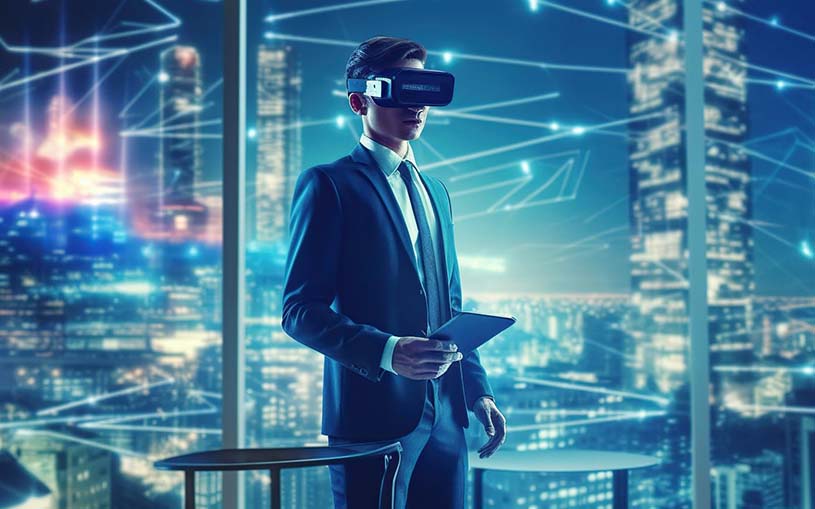Creating Realism in Virtual Reality: The Role of Generative AI in VR

Virtual Reality and Generative AI: A New Era of Digital Experiences
Virtual reality (VR) has emerged as a game-changer in how we experience digital content. As technology evolves, the realism in VR environments is becoming more immersive, largely due to the magic of generative AI. This powerful technology is reshaping how we create and interact with virtual worlds, enabling users to enjoy experiences that feel incredibly lifelike. In this piece, we’ll discover how generative AI and VR are intertwined, exploring its importance in enhancing the realism of virtual settings.
The Building Blocks of Generative AI
Generative AI consists of algorithms that can create new content by recognizing and learning from data patterns. This can range from images and text to audio and architectural designs. In the world of virtual reality, generative AI’s ability to produce realistic visuals and environments is transforming how users experience VR.
A key element of generative AI is its learning process. By utilizing models like Generative Adversarial Networks (GANs), AI learns from extensive datasets to craft realistic images. As noted in a recent study from the Journal of AR & VR,
“The use of GANs has resulted in 3D models that showcase enhanced textures and elaborate designs compared to traditional modeling techniques.”
This positions generative AI as an essential resource for developers aiming to create immersive VR experiences.
Crafting Realistic 3D Models
One of the practical uses of generative AI in VR is producing realistic 3D models. Traditional 3D modeling methods can be slow and require considerable artistic skill. However, generative AI can automate and accelerate this process, allowing for spontaneous design creation.
Tools such as NVIDIA’s GauGAN employ deep learning to transform images into 3D structures, thereby lightening the artist’s workload. According to the lead researcher,
“With GauGAN, users can create lifelike environments simply by sketching their ideas, making 3D modeling more accessible to non-experts.”
This accessibility widens the door for a variety of creators in VR development.
Elevating Sensory Inputs
Generative AI also plays a crucial role in enhancing sensory inputs, making for a more immersive experience. By adjusting visuals dynamically based on user interactions and environmental elements, AI can create more fulfilling and engaging virtual spaces.
For instance, picture how lighting and sound can shift in real-time as a user moves. A VR scene could employ generative AI to adjust the lighting as a user approaches an object, crafting a sense of reality. A report from the Virtual Reality Society highlights that
“Realistic lighting creates an immersive effect that enhances feelings of presence in a virtual space.”
Thus, the refinement of sensory inputs through AI greatly contributes to virtual immersion.
Procedural Content Generation
Another significant area where generative AI excels is procedural content generation. In this method, algorithms create content based on data, often resulting in unique and ever-changing environments each time a user logs in. This capability boosts the replay value of VR experiences, ensuring they remain engaging and less predictable.
Games like No Man’s Sky utilize procedural generation to craft limitless worlds for players to explore, demonstrating the extensive advantages of generative AI in VR environments. Developers can create diverse landscapes and interactions through this technique, allowing users to enjoy fresh experiences regardless of how often they return to the VR world.
Ethical Considerations in AI for VR
While generative AI offers numerous advantages, ethical concerns need careful consideration. With the ability to produce content at unprecedented speeds, there is growing anxiety about misinformation and the potential for harmful virtual environments.
As highlighted by ethical AI experts at a recent symposium,
“The responsibility lies with developers to create guidelines ensuring that generative AI does not propagate harmful stereotypes or misinformation.”
For VR to achieve its transformative potential, it is essential to maintain a balanced approach that reflects societal values and ethics. Conversations surrounding the ethical implications of AI in VR are vital for promoting responsible technology development.
Challenges in AI Integration
Despite its promise, incorporating generative AI into VR presents challenges. High computation costs, the need for extensive data, and the risk of subpar content are hurdles developers are tackling. Ensuring AI outputs meet quality standards is crucial for preserving the immersive experience.
Furthermore, user acceptance of AI-generated content is a critical factor in the success of these technologies. Users must feel comfortable and trust that AI-enhanced spaces will enrich their experience rather than detract from it. As voiced by a notable VR developer,
“The technology must complement human creativity rather than replace it.”
This sentiment captures the future direction of VR through generative AI.
The Horizon of VR and Generative AI
Looking to the future, the partnership between VR and generative AI opens doors to thrilling possibilities. Greater realism, wider accessibility for creators, and enriched user engagement are merely scratching the surface of what these technologies can accomplish together.
As the tech landscape continues to evolve, more sophisticated models will emerge, enabling increasingly detailed and responsive environments. Future advancements may blur the lines separating the real from the virtual world, paving the way for extraordinary experiences that redefine how we connect and interact with digital content.
In Conclusion
In summary, the interconnectedness of Generative AI and virtual reality is leading to remarkable improvements in user experiences. With the ability to produce realistic 3D models, enhance sensory interactions, and generate unique content, generative AI is expanding the horizons of what VR can provide. Ethical considerations and integration challenges must be addressed, guiding how these technologies progress in the future.
Ultimately, ongoing exploration and innovation at the crossroads of AI and VR are likely to yield astonishing advancements. As we venture into this new technological era, the possibilities are boundless, inviting both creators and users to take part in increasingly profound virtual experiences.
